The Recollections of Jane Freeman
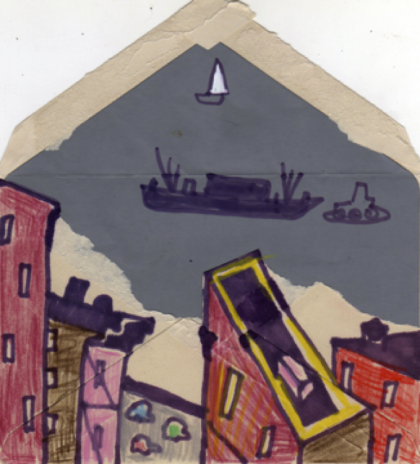 When artist Jane Freeman mentioned—in a comment on John Willenbecher’s post about Tribeca’s pioneer days—that she had some photos from back then, I emailed her to see if she’d let me run them. She was about to get a puppy, so we agreed that she’d have her hands full for a while. “I’ve also written essays, rather as John has done, about early Tribeca and how wonderfully strange everything once was,” she added. And now she’s sharing them with us. I find them marvelously evocative, and it’s the kind of writing that this site—being mainly engaged with news—rarely showcases. Note that they’re not necessarily in chronological order, and part two is forthcoming. The art is all by Jane.
When artist Jane Freeman mentioned—in a comment on John Willenbecher’s post about Tribeca’s pioneer days—that she had some photos from back then, I emailed her to see if she’d let me run them. She was about to get a puppy, so we agreed that she’d have her hands full for a while. “I’ve also written essays, rather as John has done, about early Tribeca and how wonderfully strange everything once was,” she added. And now she’s sharing them with us. I find them marvelously evocative, and it’s the kind of writing that this site—being mainly engaged with news—rarely showcases. Note that they’re not necessarily in chronological order, and part two is forthcoming. The art is all by Jane.
••••••••••••••••••••••
In Feb. 1976, when I was 26, I moved downtown to an illegal loft on Hudson Street. I shared the sixth floor with Jos. Schaffner Printing factory. The rent was $250/month. My half (1,200 sq. ft.) came with four full-size dead trees, a rickety bed cobbled from odd planks, dried up paint tubes. Until I found someone to jerry-rig a bathroom, I used the men’s room in the hallway and showered at the Y. The ceilings were so tall that eventually I had a bedroom-on-stilts built. I cooked on a hot plate, and balanced my dinner of soup on a window ledge, gazing over majestic, unpopulated, industrial spans, and sunsets over the Hudson. I’d climb out one of the enormous windows to dangle my feet on the adjacent rooftop. No one around, except the wolf-like dog that patrolled up there. I met him after my first trepidatious night in this new, dead-quiet, desolate, low-rise, 19th-century neighborhood. That first morning, waking at sunup (no curtains, no shades), I was aghast to see the wolf-dog staring in at me with feral blue eyes.
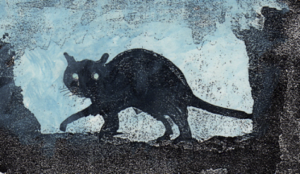 Before I left my tiny uptown flat, I’d cut out an article about Philippe Petit, who had just walked between the World Trade Center towers on a rope. At our first building meeting, I discovered that Philippe was my third-floor neighbor. On the top floor lived the manager of a famous rock band. The building was filled with artists, musicians, magicians. Philippe would leave for work on his unicycle.
Before I left my tiny uptown flat, I’d cut out an article about Philippe Petit, who had just walked between the World Trade Center towers on a rope. At our first building meeting, I discovered that Philippe was my third-floor neighbor. On the top floor lived the manager of a famous rock band. The building was filled with artists, musicians, magicians. Philippe would leave for work on his unicycle.
I had to leave the loft in 1982, when the building was sold to Howard Rower who was married to Alexander Calder’s daughter and was a mean person. The first thing he did was plaster the doors with eviction notices. (The usual story.) I moved a few blocks north to Harrison St., to a four-story walk-up over a bar. The four-room railroad flat had reptilian green walls, seven cracked, boarded up windows, and no kitchen to speak of, or bathroom—just a toilet at the end of a long dim hallway. The previous tenants had been there for 60 years and had paid $60/month. (Mine started at around $325.) The two useless wall outlets probably dated from Thomas Edison’s days. The gas jets in the narrow stairway were plugged. Each room contained an iron bed and a heavy armoire filled with Miss Havisham-type items. Since I wouldn’t dream of taking up valuable square footage with furniture, I happily got rid of everything. Rattling about in four empty rooms, I dug up ten layers of linoleum, under which were newspapers from the Korean War, and beneath them, newspapers from World War II. And beneath them, wide-plank, 19th-century floors.
Besides eschewing furniture and home decor, I also abstain from using heat. When I moved in, the radiator at one end of the flat was broken and the other, which probably had stood near the blocked-up fireplace, was missing. I disconnected the gas line. Admittedly, this was in midsummer, when one can’t imagine being cold. Every December I tape plastic dropcloths onto the windows, which don’t keep the wind from blowing cold and debris through fissures in the old walls. Only when it gets below freezing out is it a mite too chilly indoors; but there are always hot baths, fingerless gloves, root soup and coffee. And the furry animals, to cuddle up to.
••••••••••••••••••••••
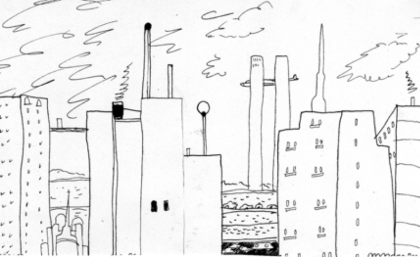 The previous tenants of this apartment left around 1980. I never met them, but there are stories about them. The Martinezes were in their late 90’s, and even though the rent was affordable—$60/month—they no longer could manage the stairs. The couple never went outside—two ancients prowling five dark rooms, bathing in a metal tub in the kitchen, two electric outlets that no modern plug would fit. The walls were painted a scaly, amphibious gray-green. Ten layers of linoleum covered the floor, beneath which were newspapers from the Korean War, beneath which were papers from World War II, beneath which were pristine, wide, dark planks. The seven windows were cracked, covered with plywood, and the wind gusted in anyway and through the leaky walls. The western windows, facing the river, must have had an ample view of ships offloading goods at the Mercantile Exchange.
The previous tenants of this apartment left around 1980. I never met them, but there are stories about them. The Martinezes were in their late 90’s, and even though the rent was affordable—$60/month—they no longer could manage the stairs. The couple never went outside—two ancients prowling five dark rooms, bathing in a metal tub in the kitchen, two electric outlets that no modern plug would fit. The walls were painted a scaly, amphibious gray-green. Ten layers of linoleum covered the floor, beneath which were newspapers from the Korean War, beneath which were papers from World War II, beneath which were pristine, wide, dark planks. The seven windows were cracked, covered with plywood, and the wind gusted in anyway and through the leaky walls. The western windows, facing the river, must have had an ample view of ships offloading goods at the Mercantile Exchange.
I can imagine something of their lives by what they left behind: four iron bedsteads, old wardrobes and bureaus, jars of false teeth, and strange all-sorts collections in collapsing boxes. When they left for good, they left everything behind, so I was the accidental heir to their trove, an accumulation of half a century. I’m told that every night, Mr. M. supped at this corner window, then pitched his leftovers and beer bottles out onto Greenwich Street. I understand the pleasure of defenestrating things. I pinch off dead houseplant leaves, or a bit of fuzz, toss them into the breeze, watch their flight, and feel a miniature frisson of terror and vertigo. A mote loops brilliantly in a china-blue sky, changes tack, zooms to a balcony across the street, opts for the air again, soars free and finally disappears, as everything eventually does. From here, the high-rise balconies seem like pigeonholes, from which just about anything not weighted down could blow away in a strong wind. In fact, last May, the wind blew a terrier from his terrace, sailed him around and landed him safely on a balcony five stories down. It would be nice to get his point of view, as one who was jettisoned from on high and lived to tell the tale.
Thrills and chills at the edge of a ledge! I place a toy car on the sill and mentally squeeze into it, on the brink of doing a Thelma-and-Louise. Bon voyage, Mr. M.! Imagination lets one play safely, and enjoy a payoff of terror, which is in fact real. Whee!
••••••••••••••••••••••
 Tribeca, 1980. Getting coffee at the bodega, I run into a neighborhood painter named Roy. I know him to nod to; walking my malamute Aleut, I sometimes see him with his shepherd, West, on West Street, or up on the West Side Highway: The truncated, disused elevation has become something of an unrestricted dog run. Roy apparently has forgotten my name, but he mentions, as an offhand invitation, a party tonight on Vestry Street. I give a “maybe I’ll drop by” shrug.
Tribeca, 1980. Getting coffee at the bodega, I run into a neighborhood painter named Roy. I know him to nod to; walking my malamute Aleut, I sometimes see him with his shepherd, West, on West Street, or up on the West Side Highway: The truncated, disused elevation has become something of an unrestricted dog run. Roy apparently has forgotten my name, but he mentions, as an offhand invitation, a party tonight on Vestry Street. I give a “maybe I’ll drop by” shrug.
Around 9 I enter a big loft space on Vestry. A throng of Isadora Duncans is leaping about in flapping Moroccan pantaloons, flying scarves and kurtas. The occasion, I learn, is a bon voyage for someone named Jacqueline, off to teach dance at the U. of Melbourne, Australia. I head for a paint-encrusted trolley converted into a temporary buffet: Twin Gallo gallons (red and white), punch bowl, Jarlesburg, Triscuits, pretzels, chips; pastel palette of dips as viscous as rabbit-skin glue. Hanging around the food are poet-types in black and purple with faces like albino rabbits, bodies like Scandinavian flatware. But most are artists, in splotched jeans half-devoured by turps and stand oil. As for me, I’ve been so busy lately with my factotum non-career, I haven’t painted in two weeks. But I dress the part: Pearl Paint t-shirt, watch cap, jeans, and spattered penny-loafers with subway tokens in the slots.
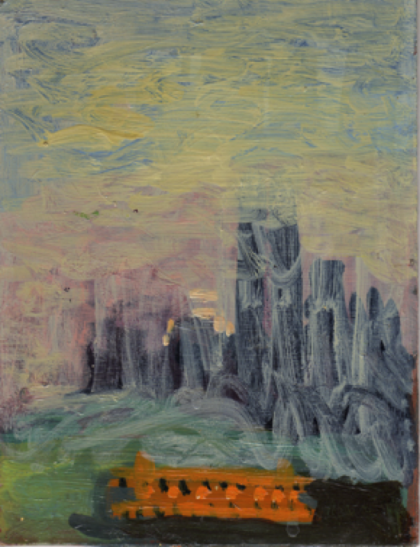 Averse to dancing and noise, I pour myself a drink and wander off to explore the rooms partitioned unpainted sheetrock or paisley bedspreads hung from string. Art is everywhere–the gloomy first bursts of dubious potential, relieved by sporadic Fauve and Nabis posters. Pinned to one wall (made of a quilt) hangs a row of postcards that track someone’s cross-country itinerary. Another makeshift space defines a kitchen of sorts. Many of the books, in stacked crates, are in duplicate or triplicate—a telltale sign of someone’s multiple relationships. The john is huge and gray; jerry-rigged shower with a plastic dropcloth curtain, strange toilet on a plinth. No sink: toothbrushes are in the kitchen, in a Bustelo coffee can.
Averse to dancing and noise, I pour myself a drink and wander off to explore the rooms partitioned unpainted sheetrock or paisley bedspreads hung from string. Art is everywhere–the gloomy first bursts of dubious potential, relieved by sporadic Fauve and Nabis posters. Pinned to one wall (made of a quilt) hangs a row of postcards that track someone’s cross-country itinerary. Another makeshift space defines a kitchen of sorts. Many of the books, in stacked crates, are in duplicate or triplicate—a telltale sign of someone’s multiple relationships. The john is huge and gray; jerry-rigged shower with a plastic dropcloth curtain, strange toilet on a plinth. No sink: toothbrushes are in the kitchen, in a Bustelo coffee can.
Back at the refreshments, I swallow another Yellow Mellow. To my surprise, a guy beckons me to dance and it’s too noisy to say no. Reluctantly I put down my cup. My partner shouts, “Are you a professional dancer?” revealing that either (1) he’s drunk, (2) he has no sense of movement, or (3) I am faking it okay. His name is Gabriel (I think); he’s in architecture school somewhere.
Pretty soon the balance fluid in my inner ear is spinning like Blue Whisk in a Maytag. I keep losing him. When the music abruptly slows and the decibels drop, he pops in front of me and takes me in his arms. The song is “I Only Have Eyes For You,” by the Flamingos. And suddenly I’m back in seventh grade. Miami, 1961. Whenever a mid-afternoon rain-shower surprises us out on the Phys. Ed. field, we’re sent to Study Hall for the rest of the period. Today, however, no such luck. We’re herded into the gym, which is unctuous with humidity, trapped air and sweat. To our collective dismay, we’re forced to dance. Above the groans and giggles, the desiccated Phys. Ed. teachers (white Bermuda shorts and polo shirts, whistles on cords around crepey necks, faces like leather handbags) warn: If we try to skip, we’ll get F’s in Effort and Conduct.
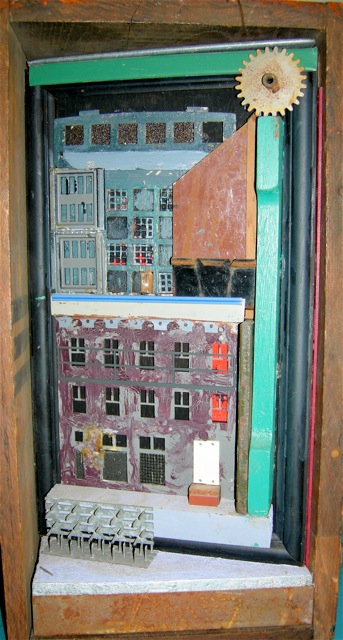 The gym is rife with pubescent reluctance. I’m poised to fight-flight-freeze. Barely 5’ tall at age 12, I’m paired with a huge, damp boy with oily black hair. We face off uneasily. A slow song scratches to a start over the staticky PA: “I Only Have Eyes For You.” Mine are fixed on his clammy, yellow-check, whale-like midsection. The boy wraps a log-like arm around my waist, engulfs my right hand in the Mazola-moist cavern of his left. He smells like Arby’s roast beef. Presently, in the malodorous atmosphere of Shenandoah Junior High, we awkwardly begin to shift from side to side.
The gym is rife with pubescent reluctance. I’m poised to fight-flight-freeze. Barely 5’ tall at age 12, I’m paired with a huge, damp boy with oily black hair. We face off uneasily. A slow song scratches to a start over the staticky PA: “I Only Have Eyes For You.” Mine are fixed on his clammy, yellow-check, whale-like midsection. The boy wraps a log-like arm around my waist, engulfs my right hand in the Mazola-moist cavern of his left. He smells like Arby’s roast beef. Presently, in the malodorous atmosphere of Shenandoah Junior High, we awkwardly begin to shift from side to side.
After a while he starts getting creative and his dips deepen. Who does he think he is, Ricky Ricardo? Now I’m leaning so far to the left that my right saddle shoe lifts high above the concrete. My foot waves in midair and I am powerless. The boy is oblivious. The Flamingos croon on and on. I feel like a flamingo myself, wings clipped, teetering on one knobby leg….
It’s not so bad, eighteen years later, here in Tribeca, shuffling anonymously to the Flamingos, this time with both feet down. Gabriel and I circle about the crowded room and find ourselves in front of a built-in wardrobe with missing doors. The shelves are crammed with wooden shapes and dusty-rusty tools, which remind me of the sculptures I’d just seen at the Louise Nevelson retrospective at the Whitney. An entire floor was divided into three rooms painted, respectively, black, white, and gold. The monochromatic sculptures, in their color-coded rooms, almost disappeared. As did I, dressed in black, lingering in guess which room.
Mrs. Nevelson arrived wearing gold and white robes, a wide-brim hat and her famous centipede eyelashes. A subdued hubbub ensued which lasted until 11, when she quietly slipped away. Hanging over the first-floor landing of the museum, I saw her climb into a long black car that had been idling on Madison. She drank something in the back seat, with three dark strangers—studio assistants? Sons? Their faces glowed like embers in the streetlamp. One of them looked like a boy I had an unrequited crush on in tenth grade, who never even knew my name. Now, come to think of it, I can’t remember his.
••••••••••••••••••••••
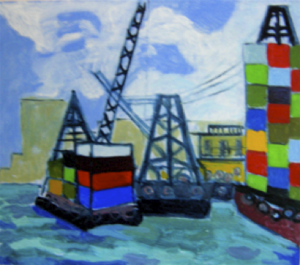 I’ve lived a block or two from the Hudson River, in lower Manhattan, since February, 1976. In those days, we’d let our dogs run on the landfill beach and make sculpture out of stuff the river washed up. Most late afternoons, when the industrial streets simmered down, I’d go to the roof to watch ocean liners, barges and tugs slip by in the transcendent hush. I’d transpose them into barks and brigs, and imagine Whitman’s “forests at the wharves.” He used the same metaphor in “The World below the Brine” (“forests at the bottom of the sea, the branches and leaves…”). I like this unintentional connecting of above and below. Living near water is conducive to going inside and sounding oneself out. The paradoxes we’re made of come to light. “Yes, as every one knows, meditation and water are wedded for ever,” says Melville, who was born on Pearl Street at the Seaport and lived in New York much of his life.
I’ve lived a block or two from the Hudson River, in lower Manhattan, since February, 1976. In those days, we’d let our dogs run on the landfill beach and make sculpture out of stuff the river washed up. Most late afternoons, when the industrial streets simmered down, I’d go to the roof to watch ocean liners, barges and tugs slip by in the transcendent hush. I’d transpose them into barks and brigs, and imagine Whitman’s “forests at the wharves.” He used the same metaphor in “The World below the Brine” (“forests at the bottom of the sea, the branches and leaves…”). I like this unintentional connecting of above and below. Living near water is conducive to going inside and sounding oneself out. The paradoxes we’re made of come to light. “Yes, as every one knows, meditation and water are wedded for ever,” says Melville, who was born on Pearl Street at the Seaport and lived in New York much of his life.
Moby-Dick begins at the Battery. Melville, the mystical cousin of Whitman (and Ryder of course), has spun me a new apprehension of life entwined with water and the call to attend the mystical. On the brink of his sea voyage, Ishmael says, “The great flood-gates of the wonder world swung open, and in the wild conceits that swayed me to my purpose…there floated into my inmost soul…one grand hooded phantom, like a snow hill in the air.”
Now little of the 19th-century maritime legacy remains in Tribeca. In the 90s, I tried to capture the old warehouses and domiciles in miniature, using indigenous found objects: a splinter from a crumbling loading dock became a miniature loading dock; a plank became a warehouse, a discarded painting some artist threw out became the wall of a tenement flat. What interested me then, before Moby-Dick, was the fugitive sense of age and of history, a desolate beauty on the brink of change. What interests me now, having read Moby-Dick, are the pointers a masterpiece provides to the timeless ineffable, and our delivery from the superficial mundane through archetypes such as Melville’s “grand hooded phantom”—whatever that may be.
After the first snow, a few weeks back, I took the dogs out before anyone was about. We began in Staple Street, where I let them romp off-leash. Then we headed to the river, which was as soft as smoke. Finding untrodden snow in the city is rare, but that morning we made all the tracks. In the North Meadow, a pair of isolated pines, triangular like arrowheads, stood out in isolate splendor against the sallow lawn. The lotus pond was solid ice, except for a scattering of spidery black star-shaped cracks through which you could see the inky water. Yellow remnants of tall pond grass stood like wattles and thatch, and were topped by cotton-boll-like dollops of new snow. The surface of the pond was glazed and pebbly and impressed with leaves like textured leaf-and-petal stationery from India. Later the stars filled in. Still, beneath the impervious glaze you could see orange koi drift eerily, as if through mercury, perhaps asleep.
What I loved best about Tribeca, besides the 19th-century buildings and the nearness of the river, were the police stables, which until recently were at the First Precinct, on Varick and Ericsson Place. Every day you’d hear hooves on paving stones, and occasionally a stentorian, air-clearing whinny. For a time in the ‘70s, just after I’d moved downtown, I worked the late shift at a Soho restaurant. I’d walk home after midnight along the deserted streets. Sometimes I’d stop at the Market Diner (long since torn down) on Laight and West, on the river. The clients in the wee hours were strange indeed—I remember four or five guys sitting in a booth, all with blue mustaches.
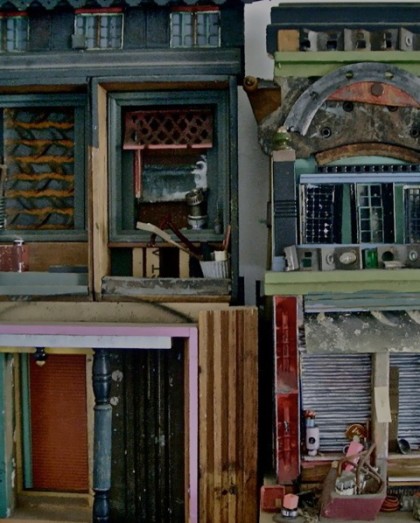 Early morning, at the river, I heard the horse before I saw him: a jetty steed named Cannon. His whinnying was so sustained and harmonic, his name could have been spelled the other way. For 20 minutes his neighing reeled and richocheted like thunder. When he cantered off, I heard him from a quarter of a mile away. Once I asked his rider what the fuss was about. “He’s a herd-bound horse,” the policewoman explained. “He’s calling out, hoping to find other horses.”
Early morning, at the river, I heard the horse before I saw him: a jetty steed named Cannon. His whinnying was so sustained and harmonic, his name could have been spelled the other way. For 20 minutes his neighing reeled and richocheted like thunder. When he cantered off, I heard him from a quarter of a mile away. Once I asked his rider what the fuss was about. “He’s a herd-bound horse,” the policewoman explained. “He’s calling out, hoping to find other horses.”
I usually see only one horse at a time on the esplanade, though sometimes there are two. Sometimes Apple and Lee are tethered together at a fence. Lee, who belongs to Officer Sean, weighs 1600 pounds, is six years old, stands 16 hands tall, and is part Clydesdale. Sean weighs about 180, is in his 30s, is about 6’3”, and looks part Viking. He answered my horse questions: the life expectancy of a horse is 40. He gets to run regularly in a paddock. Each breed has a different gait. The saddle weighs five pounds. And yes, he had named his mount. “How’d you pick ‘Lee’?” I asked. Sean said: “It’s the custom, when your partner is killed, to name your horse after him.”
••••••••••••••••••••••
Minutes ago, I heard an immense clatter of hooves. I looked out the window to see hundreds of police horses trotting down Greenwich Street. Horses of every color and many breeds—browns, greys, whites, blacks. Clydesdales, quarter horses, Appaloosas. The police stables are a few blocks away [they were moved, after this writing, in 2011]; I often hear the clip-clop of a horse or two on cobblestones. But this equine deluge was something else; a sustained, bountiful energy, a clarity of precision consonant with the brisk, joyous gait of fall. How remarkable to live near horses.
One cold, misty, full-moon night, I saw a woman emerge from the police stables with a jet-black thoroughbred. She led him to the quiet intersection of N. Moore and Varick. There was a suggestive pause, then someone else appeared, from the opposite direction. This woman was with an enormous black Great Dane. The two animals floated together, nose to nose, as in a dream. Was it an assignation? The great dog barely lifted his head; the ebony horse barely lowered his. They touched noses under the moon, then gracefully turned from each other and circled away.
Update: Comments have been turned off due to spam. To have them turned back on, email tribecacitizen@gmail.com.







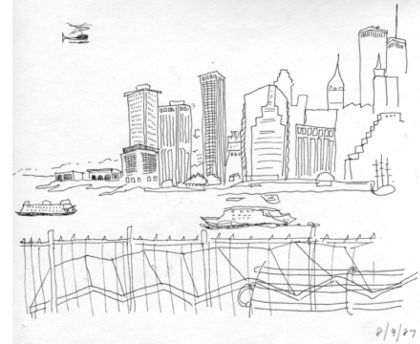
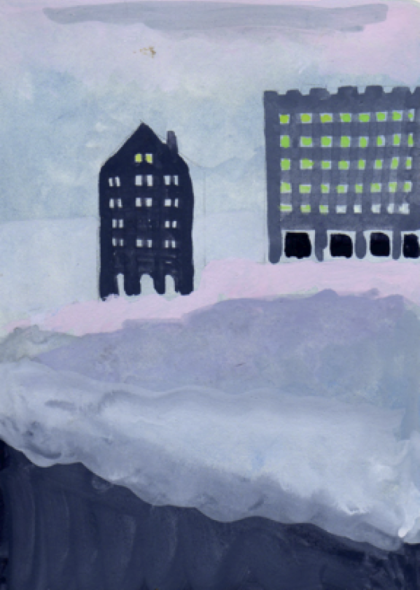
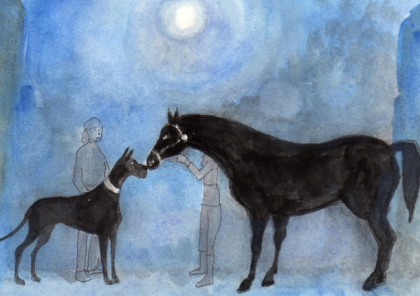






Wow, what an amazing piece. The stories are incredibly evocative and so specific, it’s easy to put yourself there. It takes a special person to live in a pioneering fashion, and I’m grateful that Ms. Freeman wrote about the experience and has shared it with us now. I especially enjoyed the horse stories. Her art is fantastic, the sketches, paintings and sculpture are all very expressive and full of memory.
Thank you Eric. Thank you Jane. Magical.
That was really lovely in every way..thanks!
thank you so much for this piece which was so entertaining and evocative. we moved into 1 hudson in 83 just after you left and had to deal with the maniac howard rower. your writing inspires me to put together my own recollections of those times when you walked down the street and knew everybody. now it seems we are strangers in our own land. i like your paintings too!
I moved o n Moore in 1977 and have even here ever since and I was transported by your writing and images. The sound of the horses plodding away in the morning and jauntily clomping home at the end of a shift marked my days. I miss it.
Thank you e and jane
Jane: What a wonderful, wonderful piece. Thank you so much.
Beautiful Jane. Thanks for sharing the writing and art work with us. Look forward to the next installment. Thanks Erik for putting it in the “Citizen”
Wow, these stories are beautiful. Thanks so much for bringing them to us!